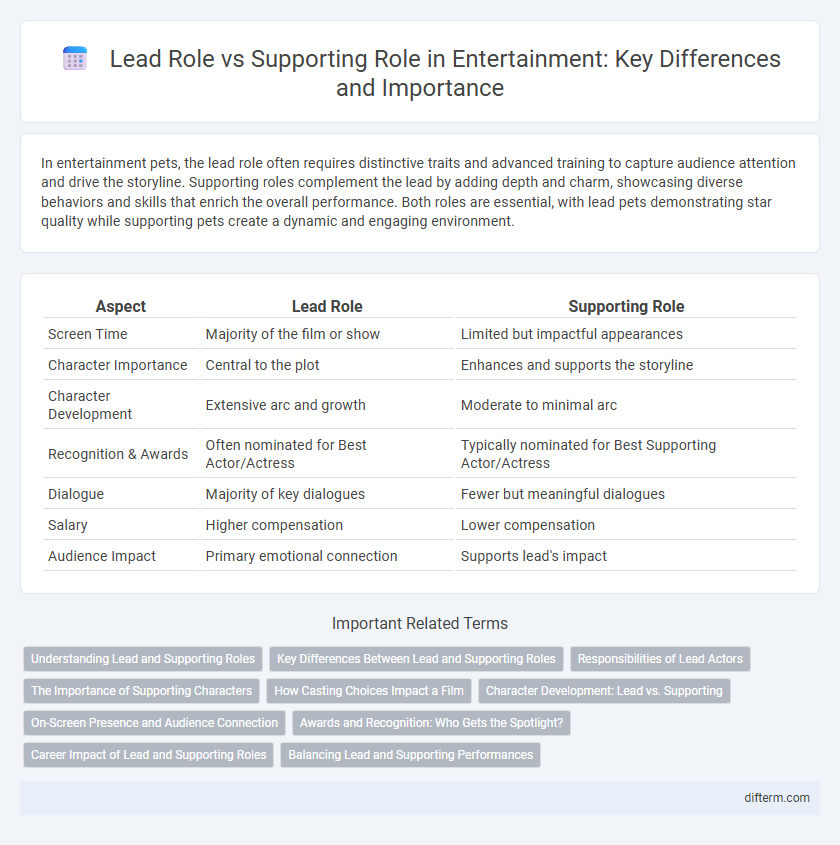In entertainment pets, the lead role often requires distinctive traits and advanced training to capture audience attention and drive the storyline. Supporting roles complement the lead by adding depth and charm, showcasing diverse behaviors and skills that enrich the overall performance. Both roles are essential, with lead pets demonstrating star quality while supporting pets create a dynamic and engaging environment.
Table of Comparison
| Aspect | Lead Role | Supporting Role |
|---|---|---|
| Screen Time | Majority of the film or show | Limited but impactful appearances |
| Character Importance | Central to the plot | Enhances and supports the storyline |
| Character Development | Extensive arc and growth | Moderate to minimal arc |
| Recognition & Awards | Often nominated for Best Actor/Actress | Typically nominated for Best Supporting Actor/Actress |
| Dialogue | Majority of key dialogues | Fewer but meaningful dialogues |
| Salary | Higher compensation | Lower compensation |
| Audience Impact | Primary emotional connection | Supports lead's impact |
Understanding Lead and Supporting Roles
Lead roles are central characters who drive the plot and receive the most screen time, often shaping the story's direction and emotional impact. Supporting roles complement the lead by enhancing the narrative, providing depth, and adding complexity to the storyline without overshadowing the main character. Understanding the distinction between lead and supporting roles is essential for casting decisions, character development, and analyzing a production's overall dynamic.
Key Differences Between Lead and Supporting Roles
Lead roles drive the narrative with significant screen time and character development, often bearing the emotional core of a film, television show, or play. Supporting roles enhance the story by complementing the lead, providing depth and context, and cushioning pivotal scenes without overshadowing the protagonist. The distinction lies in their impact, with lead roles anchoring the plot trajectory while supporting roles enrich the overall storytelling experience.
Responsibilities of Lead Actors
Lead actors carry the primary responsibility of driving the narrative and embodying the central character's emotional journey throughout the film or play. They must deliver consistent, nuanced performances that maintain audience engagement and credibility across multiple scenes and complex character developments. Collaborating closely with directors and supporting actors, lead actors often influence the production's overall tone and pacing, making their role pivotal to the project's success.
The Importance of Supporting Characters
Supporting characters enrich the narrative by providing depth and context to the lead role, making the story more relatable and immersive. Their interactions and growth often reveal critical plot points and emotional layers that drive the protagonist's development. Recognizing the importance of supporting roles highlights how ensemble dynamics contribute to a compelling and balanced entertainment experience.
How Casting Choices Impact a Film
Casting choices significantly influence a film's narrative depth and audience engagement by determining which actors embody lead and supporting roles, thereby shaping character dynamics and emotional resonance. Lead roles often drive the plot and attract viewers through star power, while supporting roles enrich the story by providing critical context and enhancing the protagonist's journey. Effective casting maximizes on-screen chemistry and believability, ultimately affecting a film's critical acclaim and commercial success.
Character Development: Lead vs. Supporting
Lead roles often undergo significant character development, showcasing complex emotional arcs and transformative journeys that drive the narrative forward. Supporting roles typically emphasize complementary traits or catalytic interactions that enhance the lead's storyline without extensive personal evolution. Both roles contribute distinctly to storytelling depth, balancing protagonist growth with enriched relational dynamics.
On-Screen Presence and Audience Connection
Lead roles command significant on-screen presence, driving the narrative and maintaining audience engagement throughout the film or show. Supporting roles enhance the story by providing depth and contrast, often creating memorable interactions that enrich the lead's portrayal. The dynamic between lead and supporting characters shapes the overall audience connection, making both essential for a compelling entertainment experience.
Awards and Recognition: Who Gets the Spotlight?
Lead roles often receive the majority of awards and recognition, as they drive the narrative and embody the primary character arc in films and television. Supporting roles, while crucial to storytelling, typically garner secondary acclaim through categories like Best Supporting Actor or Actress, highlighting their contribution without overshadowing the leads. Major award ceremonies such as the Oscars and Golden Globes distinctly separate lead and supporting categories to ensure recognition is distributed based on role significance and screen time.
Career Impact of Lead and Supporting Roles
Lead roles often provide actors with greater visibility, leading to increased recognition and more lucrative opportunities in the entertainment industry. Supporting roles can showcase versatility and depth, allowing actors to build a strong portfolio and industry credibility that may lead to future lead opportunities. Both lead and supporting roles contribute uniquely to career growth by enhancing an actor's range, marketability, and professional network within film and television.
Balancing Lead and Supporting Performances
Balancing lead and supporting performances is essential for creating a cohesive storytelling experience in entertainment. Lead roles drive the main narrative and character development, while supporting roles enrich the plot by adding depth, context, and emotional complexity. Effective collaboration between lead and supporting actors enhances the overall impact of film, television, or theater productions, ensuring that each role complements the other to engage audiences fully.
lead role vs supporting role Infographic

 difterm.com
difterm.com